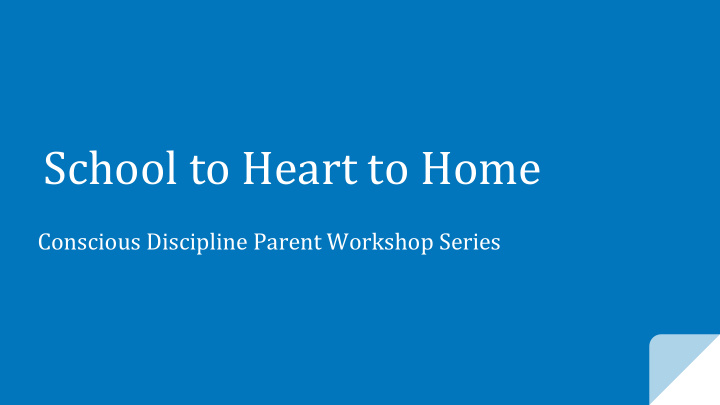



School to Heart to Home Conscious Discipline Parent Workshop Series
What are the outcomes of the parent workshop series? ● To increase the social-emotional intelligence of all families of children ages birth-preK through the use of Conscious Discipline. ● Unite schools and homes in common goals. ● Promotes a perceptual shift that unifies us in seeing misbehavior as a missing skill that must be learned. ● Equip us with proven strategies to teach children missing social-emotional skills .
What is Conscious Discipline? .. .an evidence-based, brain research based, comprehensive, multidisciplinary, self-regulation program. It addresses the emotional intelligence of adults first and children second. The three core components of Conscious Discipline: 1) Survival State--Safety--Composure, Assertiveness 2) Emotional State--Connection--Encouragement, Choices, Empathy 3) Executive State--Problem solving--Positive Intent, Consequences
Common Discipline vs. Conscious Discipline -Quick obedience -Long term learning -Do as I say, not as I do. -Discipline as teaching missing skills -Fear based -Conflict is an opportunity to learn -Reactive -Connection is prioritized -Punishments (time outs) -Focused on self-regulation for adults and children to work through a problem together -Focused on what the adult wants to happen in any given situation
1. Composure The 7 2. Assertiveness 3. Encouragement Powers of 4. Choices Conscious 5. Empathy Adults 6. Positive Intent 7. Consequences
Composure: skills of composure.. Helps us reclaim our power by learning to calm ourselves in times of distress. Being the Person Creates a pause that allows us to choose to you want Children behave in ways that are helpful and model the to become. behaviors we hope children will use. Adult Goal: To be the person we want others An upset adult is to become and remain calm enough to teach ALWAYS a threat to children by example a children’s sense of Child Goal: To develop the ability to actively safety. calm and regulate emotions Dealing with disrespect while being composed video clip
Children are only as self-regulated as we are as parents. Our role is to act as their prefrontal lobe and guide them towards calm. Video clip on public tantrums
Activity: At your seat, practice what active breathing looks like. S.T. A. R Stop, Take a deep breath and relax. Now, tell yourself, “ I am safe, I am calm, I can handle this.” Last, wish the other person well.
Make Me Language YES NO “I am going to … ” “Don’t make me … .”. “I am going to take a few “You are driving me deep breaths … ” nuts..” “See her face...her face is “Look how you made saying … ” her feel … ”
Safe Place The safe place is where children learn and practice the skill of self-regulation. The ability to self-regulate is the #1 predictor of lifelong success.
The Safe Place changes with age
Inner Peace
Wrap Up Activity 1. Get into small groups of 4-5 adults 2. Introduce yourself and discuss with your peers: a. Something from the session that personally impacts you or your family. b. Two things you are going to try at home
Next Parent Workshop Session: Skill: Assertiveness October 16th 8:30-9:30 am RSVP
Recommend
More recommend